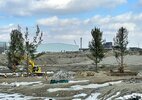clarkburglar
New Member
Can you provide more details on this? They wanted to building a European style street grid but it was vetoed by the fire department?I suspect Fire Services would veto that design., for one - there were similar discussions in the early days of the Regent Park plan.
AoD
